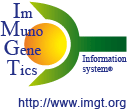Here you are: IMGT Web resources > IMGT Education
Amino acids
Amino acid abbreviations, characteristics, volume and hydropathy index
Click on the 3 letter abbreviations for GIF image (IMB, Jena, Germany).
| Amino acid | Abbreviations | Molecular mass (Da) |
Number of atoms |
Volume (A3) [1] |
Hydropathy index [2] |
|
|---|---|---|---|---|---|---|
| Alanine | Ala | A | 89 | 13 | 88.6 | 1.8 |
| Arginine | Arg | R | 174 | 26 | 173.4 | -4.5 |
| Asparagine | Asn | N | 132 | 17 | 114.1 | -3.5 |
| Aspartic acid | Asp | D | 133 | 16 | 111.1 | -3.5 |
| Asparagine or Aspartic acid | Asx | B | ||||
| Cysteine | Cys | C | 121 | 14 | 108.5 | 2.5 |
| Glutamine | Gln | Q | 146 | 20 | 143.8 | -3.5 |
| Glutamic Acid | Glu | E | 147 | 19 | 138.4 | -3.5 |
| Glutamine or Glutamic acid | Glx | Z | ||||
| Glycine | Gly | G | 75 | 10 | 60.1 | -0.4 |
| Histidine | His | H | 155 | 20 | 153.2 | -3.2 |
| Isoleucine | Ile | I | 131 | 22 | 166.7 | 4.5 |
| Leucine | Leu | L | 131 | 22 | 166.7 | 3.8 |
| Lysine | Lys | K | 146 | 24 | 168.6 | -3.9 |
| Methionine | Met | M | 149 | 20 | 162.9 | 1.9 |
| Phenylalanine | Phe | F | 165 | 23 | 189.9 | 2.8 |
| Proline | Pro | P | 115 | 17 | 112.7 | -1.6 |
| Serine | Ser | S | 105 | 14 | 89.0 | -0.8 |
| Threonine | Thr | T | 119 | 17 | 116.1 | -0.7 |
| Tryptophan | Trp | W | 204 | 27 | 227.8 | -0.9 |
| Tyrosine | Tyr | Y | 181 | 24 | 193.6 | -1.3 |
| Valine | Val | V | 117 | 19 | 140.0 | 4.2 |
- Da: Dalton
1 Da = 1.66x10-24g(1 Dalton is the unit of mass defined as one twelfth of the mass of the carbon atom 12C, that is 12/12N gram or 1/N gram).N (Avogadro number) = 6.023 x 1023. N (Avogadro number) = 6.023 x 1023. A team of the Physikalisch-Technische Bundesanstalt Braunschweig (Office fédéral allemand de métrologie de Brunswick) has determined, in 2003, a new value of the Avogadro number :
NA ≈ 6,0221353 x 1023 mol-1- One Dalton is more or less equivalent to the mass of one hydrogen atom. The molecular mass, in Daltons, of a molecule is the mass of the atoms by reference to hydrogen.
The mean molecular mass of an amino acid is 136.75 Da. - The mean number of atoms per amino acid is 19.20.
- A polypeptide chain of 1kDa corresponds approximately to 8.42 amino acid residues (118.75 Da, 16.20 atoms) and to 136 atoms.
Å3: Angström3
Statistics on the volumes for buried core atoms in a database of 119 structures
Specific volume calculator for amino acid sequence (by Tracy Nixon)
The program determines the number of each type od amino acid. Then it adds up the molecular weight, and calculates the specific volume using the Cohn-Edsall values [3]. The values were taken from Table II in Zamyatnin (1972) [1]. These values have been confirmed with volumes taken from crystal structures [4]. Also reported are extinction coefficient (calculated assuming additivity using 3500 per Mcm for tryptophans, and 1200 per Mcm for tyrosines [5], and the amino acid composition.
To convert ml/mole from the Zamyatnin's paper to Å3
1L = 1 dm3 = 0,001 m3 = 10-3 m3
1mL = 10-3 L = 10-3 dm3 = 10-6 m31Å = 10-10 m → 1Å3 = 10-30 m31Å3 = 10-30 m3 = 10-24 mL
As mole is a measure of quantity, this conversion is divided by the Avogadro number.
ml/mole X |
10-24 |
= Å3 |
| —————— | ||
6.023x10-23 |
ml/mole X |
10 |
= Å3 |
| —————— | ||
6.023 |
The Kyte-Doolittle (KD) and Goldman-Engelman-Steitz (GES) hydropathy scale comparison [7]
| Amino acid | KD [2] | GES [6] |
|---|---|---|
| I | 4.5 | 3.1 |
| V | 4.2 | 2.6 |
| L | 3.8 | 2.8 |
| F | 2.8 | 3.7 |
| C | 2.5 | 2.0 |
| M | 1.9 | 3.4 |
| A | 1.8 | 1.6 |
| G | -0.4 | 1.0 |
| T | -0.7 | 1.2 |
| S | -0.8 | 0.6 |
| W | -0.9 | 1.2 |
| Y | -1.3 | -0.7 |
| P | -1.6 | -0.2 |
| H | -3.2 | -3.0 |
| E | -3.5 | -8.2 |
| Q | -3.5 | -4.1 |
| D | -3.5 | -9.2 |
| N | -3.5 | -4.8 |
| K | -3.9 | -8.8 |
| R | -4.5 | -12.3 |
| [1] | Zamyatnin, A.A., Protein volume in solution, Prog. Biophys. Mol. Biol., 24:107-123 (1972), PMID: 4566650. |
| [2] | Kyte, J. and Doolittle, R.F., J. Mol. Biol., 157:105-132 (1982). |
| [3] | Cohn, E.J. and Edsall, J.T., In: Proteins, amino acids and peptides. Rheinhold Publishing Corporation, New York., pp. 155-176 and pp.370-381 (1943). |
| [4] | Perkins, S.J., Protein volumes and hydration effects. The calculations of partial specific volumes, neutron scattering matchpoints and 280-nm absorption coefficients for proteins and glycoproteins from amino acid sequences. Eur. J. Biochem., 157:169-80 (1986), PMID: 3709531. |
| [5] | Wetlaufer, D.B., Adv. Prot. Chem., 17:303-390 (1962). |
| [6] | Engelman, D.M., Steitz, T.A. and Goldman A., Annu. Rev. Biophys. Biophys. Chem., 15:321-353 (1986), PMID: 3521657. |
| [7] | Zviling, M., Leonov, H. and Arkin, I.T., Bioinformatics, 21(11):2651-2656 (2005), PMID: 15797910. |




